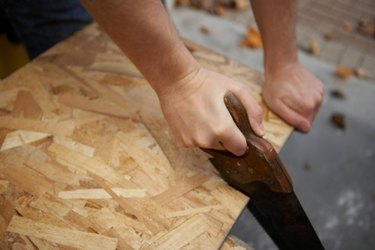Things You'll Need
Safety glasses
Sheet of 3/4-inch MDF (medium density fiber board)
Adjustable wrench
Drill with bit
Framing square

The radial arm saw has a sacrificial front table that you must replace from time to time after use. Most radial arm saws are built with a steel frame and a wooden tabletop. The main reason for this it that the saw blade will penetrate the tabletop for most cutting operations.
Step 1
Unplug the radial arm saw for safety.
Video of the Day
Step 2
Raise the saw to get access to the table.
Step 3
Remove the old top. Most radial arm saws have a three-part table: The rear table acts as a clamp to hold the rip fence in place. The rip fence supports the wood and keeps it perpendicular to the blade. The front table is the cutting surface. Most cuts on the saw will cut through the fence and the work material and into the front table. For most radial arm saws, the rear table and the rip fence are clamped in place between wing bolts at the rear and the front table. When the wing bolts are loosened, the rear table and the rip fence are removable. The front table is attached with four or more recessed bolts that are accessible under the saw where it attaches to the steel base.
Step 4
Cut the new top to size, using the existing front table as a template. Drill the bolt holes to match the old top. One of the best materials to use for the front table is 3/4-inch medium density fiberboard (MDF). It is inexpensive, durable, easy to work with and won't harm the blade when it is cut into.
Step 5
Attach the new top to the steel frame. Install the rip fence and rear table.
Step 6
Check the saw for square. Lower the saw until the blade meets with the front table. Raise the blade 1/4 turn. Place a framing square on the front edge of the front table and next to the blade. Pull the saw forward. The blade should not dig into the top or pull away during travel. Adjust as required by loosening the bolts from under the front table where it attaches to the steel base. Retighten the bolts.
Step 7
Check the table to be sure it is flat. Lower the blade until it contacts the front table. Raise the blade 1/2 turn. Pull the blade forward slowly, noting the gap between the table and the blade. The gap should be the same throughout its travel. Adjust the saw to 45 degrees left and right, and check the gap again. It should maintain the same gap throughout the blade's travel. If it is not flat and true, shim the top from below as required until it is true.
Step 8
Start the saw and lower the blade1/8 inch into the table and pull forward. Repeat for 45-degree cuts left and right of center. This will provide reference marks on your new table.
Tip
Wear safety glasses whenever you turn on the saw. Save the old front table as a template. It is best to round the front corners of the new front table to avoid sharp edges. Be sure to countersink the bolts so that they will not interfere with the table's surface.
Warning
Always disconnect the power before working on power tools. Wear safety glasses when operating power tools.
Video of the Day